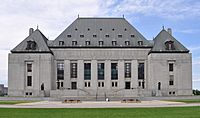Reference Re Eskimos facts for kids
Quick facts for kids Reference Re Eskimos |
|
|---|---|

|
|
| Hearing: 17 June 1938 Judgment: 5 April 1939 |
|
| Full case name | Reference whether "Indians" includes "Eskimo" |
| Citations | [1939] 2 DLR 417; [1939] SCR 104 |
| Prior history | None (reference question) |
| Holding | |
| For the purposes of section 91(24) of the British North America Act, 1867, the Inuit are Indians. | |
| Court membership | |
| Chief Justice: Lyman Duff Puisne Justices: Thibaudeau Rinfret, Lawrence Arthur Dumoulin Cannon, Oswald Smith Crocket, Henry Hague Davis, Patrick Kerwin, Albert Hudson |
|
| Reasons given | |
| Majority | Duff CJ, Hudson and Davis JJ, joined by Crocket J |
| Concurrence | Cannon J, joined by Crocket J |
| Concurrence | Kerwin J, joined by Cannon and Crocket JJ |
| Rinfret J took no part in the consideration or decision of the case. | |
The case of Reference Re Eskimos is an important decision from the Supreme Court of Canada. It helped decide who should be responsible for the Inuit people in Canada. At the time, the term "Eskimo" was used, but today we use "Inuit."
The main question was about a part of Canada's rulebook, the Constitution Act, 1867 (then called the British North America Act, 1867). This rulebook says the federal government (Canada's national government) is in charge of "Indians, and Lands reserved for the Indians." The Supreme Court had to figure out if the Inuit should be included in the term "Indians" for this specific law. The Court decided that, yes, for this law, Inuit should be considered "Indians."
Contents
Why This Case Happened
This case came about because there was confusion. No one was sure if the federal government or the provincial government of Quebec should be responsible for the Inuit living there.
When the British North America Act was first created in 1867, Canada was much smaller. There were very few, if any, Inuit in the parts of Canada that existed then. However, the Constitution allowed for new lands to join Canada. So, Inuit living in Rupert's Land later became part of Quebec.
At the time of this case, the federal government didn't want to take on the responsibility for the Inuit. They argued that the word "Indians" in an older document, the Royal Proclamation of 1763, did not include the Inuit. They thought this older document should help explain the meaning in the British North America Act.
The Court's Decision
The Supreme Court judges looked at many old documents and historical facts to make their decision. Several judges wrote their own reasons for agreeing with the final outcome.
Chief Justice Duff's View
Lyman P. Duff, who was the top judge (Chief Justice) at the time, looked at evidence from the Hudson's Bay Company. This company used to govern a large area called Rupert's Land. In the 1850s, a committee in the British Parliament looked into how the company dealt with the Inuit. The Hudson's Bay Company's report referred to Inuit as a type of "Indian."
Chief Justice Duff also found that Inuit in Labrador were often called "Indians" around the time the British North America Act was adopted. He noted that official records from 1762 called Inuit "savages," just like some Indian tribes were called. Even important people like Prime Minister John A. Macdonald, who helped create Canada, talked about Inuit as "Indians" in 1879.
The federal government had argued that the Royal Proclamation of 1763 defined "Indians" as "nations or tribes," and that Inuit communities weren't described that way. But Duff found evidence that contradicted this. He also questioned whether that old proclamation should even be used to interpret the British North America Act.
Justices Albert Hudson and Henry Hague Davis agreed with Chief Justice Duff's reasons.
Justice Cannon's View
Justice Lawrence Arthur Dumoulin Cannon also believed Inuit should be considered "Indians." He pointed to the same 1857 report by Sir George Simpson that called Inuit "Indians." Justice Cannon thought that the British lawmakers in 1867 would have known about this report.
He also looked at the Quebec Conference of 1864, where Canadian leaders discussed how the new country would be set up. One resolution said the federal Parliament should govern "Indians and Lands reserved for the Indians." In the French version of this resolution, the term was translated as "Les Sauvages et les terres réservées pour les Sauvages." Justice Cannon felt this meant all Indigenous peoples in British North America, including those in Newfoundland.
Justice Kerwin's View
Justice Patrick Kerwin also agreed that Inuit were "Indians" for the purpose of the law. He felt that when the British North America Act mentioned "Indians," it was meant to include all Indigenous peoples. He found historical evidence that explorers like Samuel de Champlain and missionaries often grouped "Indians" and "Inuit" together, sometimes calling them "sauvages" or "sauvages esquimaux."
Justice Kerwin also noted that some older dictionaries included Inuit as "Indians," even though newer ones from the early 1900s did not.
Justice Crocket's View
Justice Oswald Smith Crocket wrote a short opinion agreeing with both Justice Cannon and Justice Kerwin.
See also
- List of Supreme Court of Canada cases (Richards Court through Fauteux Court)
- The Canadian Crown and First Nations, Inuit and Métis
- Canadian Aboriginal case law
- Numbered Treaties
- Indian Act
- Section Thirty-five of the Constitution Act, 1982
- Indian Health Transfer Policy (Canada)

